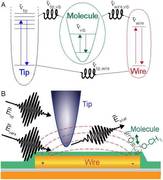Nano-imaging and control of molecular vibrations through electromagnetically induced scattering reaching the strong coupling regime
| Reviews and Highlights | Quantum Science | Molecular and Soft-matter | Ultrafast Nano-optics and Nanophotonics | Mineralogy and Geochemistry |
|---|
Eric Anton Muller, Benjamin Pollard, Hans A. Bechtel, Ronen Adato, Dordaneh Etezadi, Hatice Altug, and Markus B. Raschke
ACS Photonics 5, 3594 (2018).
DOI PDF SI

Optical resonators can enhance light-matter interaction, modify intrinsic molecular properties such as radiative emission rates, and create new molecule-photon hybrid quantum states. To date, corresponding implementations are based on electronic transitions in the visible spectral region with large transition dipoles yet hampered by fast femtosecond electronic dephasing. In contrast, coupling molecular vibrations with their weaker dipoles to infrared optical resonators has been less explored, despite long lived coherences with two orders of magnitude longer dephasing times. Here, we achieve excitation of molecular vibrations through configurable optical interactions of a nanotip with an infrared resonant nanowire that supports tunable bright and non-radiative dark modes. The resulting antenna-vibrational coupling up to 47 +/- 5 per cm-1 exceeds the intrinsic dephasing rate of the molecular vibration, leading to hybridization and mode splitting. We observe nanotip induced quantum interference of vibrational excitation pathways in spectroscopic nano-imaging, which we model as electromagnetically induced scattering (EIS) as the phase-controlled plasmonic analogue of optically induced transparency (EIT) and absorption (EIA). Our results present a new regime of IR spectroscopy for applications of vibrational coherence from quantum computing to optical control of chemical reactions.
